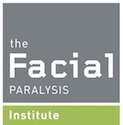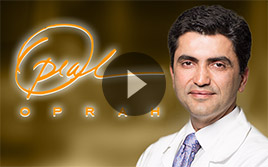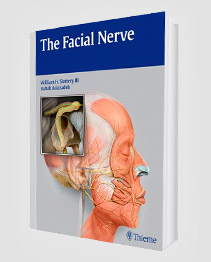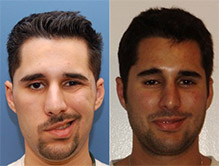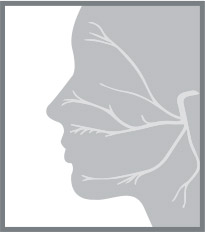What Are The Causes of Pediatric Bell’s Palsy?
Pediatric Bell’s palsy can affect any child. The condition refers to facial weakness or paralysis, and it can be caused by damage to the 7th cranial (facial) nerve. This nerve sends messages from the brain to each side of the face, controlling everything from blinking to smiling to helping produce tears. Sometimes, this nerve becomes swollen or gets constricted. This impedes the role of the nerves, resulting in facial weakness or paralysis on one side of the face or head. Common causes for nerve compression or swelling include:
- HSV-1, the same virus responsible for cold sores
- Epstein-Barr, the virus that causes mononucleosis, or “mono”
- Influenza
- Severe colds
- Ear infections
- Trauma to the head or face
- Lyme disease
In some cases, children may not even know they have had one of the viruses that can cause inflammation or constriction of the 7th cranial nerve. Paralysis due to Bell’s palsy tends to occur after the infection or virus has run its course. Only once the paralysis begins do the children or their parents notice something is wrong. However, older children may complain of pain around the ears shortly before paralysis occurs.
It is important to understand that there are differences between congenital facial paralysis and Bell’s palsy in kids. Congenital facial paralysis is a type of facial palsy that affects children at birth. It is a rare condition that makes it difficult for a newborn to fully open or close the eyes. If congenital facial paralysis goes unaddressed, it may impact the development of a child’s ability to make emotional expressions and speak.
SYMPTOMS OF BELL’S PALSY IN CHILDREN
Bell’s palsy in children often results in sudden, unexplained facial paralysis. A pediatric Bell’s palsy patient may experience a sensation in the face that makes it difficult to perform facial movements. The most common symptoms include:
- Discomfort around the jaw and/or behind the ear
- Drooling
- Drooping of the eyelid and/or corner of the mouth
- Dryness of the eye or mouth
- Excess tearing in one eye
- Headache
- Impairment of taste
- Mild facial weakness
- Ringing in one or both ears
- Twitching or paralysis of one or both sides of the face
In young children, parents may only notice outward symptoms, such as restricted movement in one side of their child’s face. Older children may be able to express the more internally felt symptoms, such as headache and ringing in the ears. The child should be taken to the emergency room the moment a parent or caregiver notices that they appear to be suffering from sudden facial paralysis.
While strokes in children are rare, they can occur. As with Bell’s palsy, stroke symptoms come on suddenly, but they usually affect more than just the face, causing weakness in one side of the body, difficulty walking, and even seizures. Regardless, any child with symptoms of facial paralysis should be seen by a doctor to rule out a stroke.
DIAGNOSING BELL’S PALSY IN CHILDREN
To diagnose Bell’s palsy, a doctor may do several things. They may ask how long the child has been experiencing symptoms and conduct a physical exam to determine the location and extent of the paralysis, which can help the doctor rule out a stroke.
Brain tumors can also cause facial paralysis in children, but the symptoms tend to develop slowly and become more severe over time. The doctor may choose to order X-rays, magnetic resonance imaging (MRI), electromyography (EMT), or computed tomography (CT) scans to check for potential problems.
Caregivers should alert the doctor to any recent illnesses the child has had. In most cases, the viruses or infections will be gone or on the mend by the time paralysis occurs, but knowing about recent illnesses can help the doctor make an accurate diagnosis. After a doctor diagnoses a child with Bell’s palsy, they can begin to recommend treatments to help ease or improve symptoms.
HOW IS BELL’S PALSY TREATED IN CHILDREN?
A child who experiences any of the aforementioned symptoms should immediately go to an emergency room for diagnosis. A doctor will treat a pediatric Bell’s palsy patient based on the individual’s symptoms and medical history. Common Bell’s palsy treatment options include:
- Analgesics (painkillers) to alleviate pain
- Physical therapy to stimulate the facial nerve
- Steroid medications to limit inflammation
Most cases of pediatric Bell’s palsy go away on their own once the 7th cranial nerve heals from any damage, typically within one to three months. During this time, the doctor may recommend the child visit an ophthalmologist to receive treatment for an eye that won’t close, such as eye drops, an eye patch, or special tape to keep the eye closed until facial movement is restored. Children should also get plenty of rest and nutritious food to help aid the healing process.
In some instances, facial paralysis symptoms linger for longer than three months. If the symptoms linger for eight months or longer, a consultation with Dr. Babak Azizzadeh of The Facial Paralysis Institute may be necessary to address this condition using facial reanimation surgery, Botox, or other treatments.
WHAT IS FACIAL REANIMATION SURGERY?
When facial paralysis lasts for eight months or more, it is likely that advanced intervention is needed to help a child regain some of the function lost to Bell’s palsy. If children cannot eat, blink, or speak properly, or if they are experiencing unwanted spasms in the face (synkinesis), they and their caregivers may wish to consider facial reanimation surgery.
There are several forms of this surgery, including:
- Muscle transfer: in this type of surgery, muscle fibers or tendons are moved to certain parts of the face, enabling increased movement. A temporalis tendon transfer, or T3 procedure, moves part of the temporalis tendon, which is attached to the jaw, nearer to the mouth. A gracilis transfer uses muscle fibers from the inner thigh and transfers them to the face.
- Nerve grafting: this procedure relocates nerves from various parts of the body to the face, where they can help the patient regain movement, muscle control, and sensation in the face.
- Gold eyelid weight: if one of the lingering issues facing a child is the inability to close the eyelid, Dr. Azizzadeh can surgically implant a gold weight into the eyelid, restoring functionality.
Dr. Azizzadeh has dual certification in facial plastic and reconstructive surgery and otolaryngology (head and neck surgery). He understands that facial paralysis can result in self-esteem and self-confidence issues in children and teenagers, and he is happy to help patients restore lost functionality. His extensive expertise has made him one of the most sought-after facial plastic and reconstructive surgeons for treatment of pediatric Bell’s palsy and facial paralysis.
Dr. Azizzadeh takes a holistic approach to pediatric Bell’s palsy treatments. He knows that each patient is unique and will learn about a patient to provide a personalized plan. He also employs a team of facial paralysis experts who can diagnose Bell’s palsy in children.
To address pediatric Bell’s palsy symptoms, Dr. Azizzadeh will meet with the child and his or her parents. He will learn about the patient’s medical history and symptoms and perform a series of tests to evaluate the individual’s condition. Then, Dr. Azizzadeh can determine which facial reanimation treatment will work best.
BOTOX TREATMENTS FOR PEDIATRIC BELL’S PALSY
In some cases, Dr. Azizzadeh may recommend Botox to treat Bell’s palsy in children. He generally recommends Botox when the patients are in their teen years, but in some cases may start Botox treatments at a younger age. He will determine this after evaluating a pediatric patient.
Botox uses a protein derived from the botulinum toxin to counteract facial paralysis symptoms. It helps relax unwanted muscle movements on the normal side of the face and reduces tension in areas of the face that are hyperactive due to synkinesis.
Botox treatments are generally painless, and injections take only a few minutes to administer. Pediatric Bell’s palsy patients usually can return to their normal daily activities immediately after Botox treatments.
It takes one to two weeks to see the full results of Botox treatments, and the results last approximately four months. After Botox wears off, a pediatric Bell’s palsy patient will need to return to the Facial Paralysis Institute for another treatment with Dr. Azizzadeh.
NEUROMUSCULAR RETRAINING (NMR) THERAPY
In addition to surgical treatment and Botox, Dr. Azizzadeh may also recommend neuromuscular retraining (NMR) with an expert physical therapist. NMR requires a patient to work with a physical therapist to identify facial muscles that are contracting abnormally and retrain the coordination of appropriate facial muscle movements. It involves a multi-stage process that enables a pediatric Bell’s palsy patient to retrain the facial muscles at the neurological (brain) level.
Before undergoing NMR, a pediatric Bell’s palsy patient will be evaluated by an expert neuromuscular therapist to determine the proper exercises. Each pediatric Bell’s palsy patient has a distinct functional profile, and there is no one physical therapy protocol that works for everyone. After the evaluation, the patient will learn the exact exercises for maximum benefit.
SCHEDULE A PEDIATRIC BELL’S PALSY CONSULTATION
Dr. Azizzadeh is happy to evaluate pediatric Bell’s palsy patients and provide insights into both surgical and non-surgical treatments. To schedule a consultation with Dr. Azizzadeh, contact us online or call us today at (310) 657 2203.
Request your consultation with Dr. Azizzadeh today
Call us at (310) 657-2203 to schedule an appointment.
Schedule a Consultation